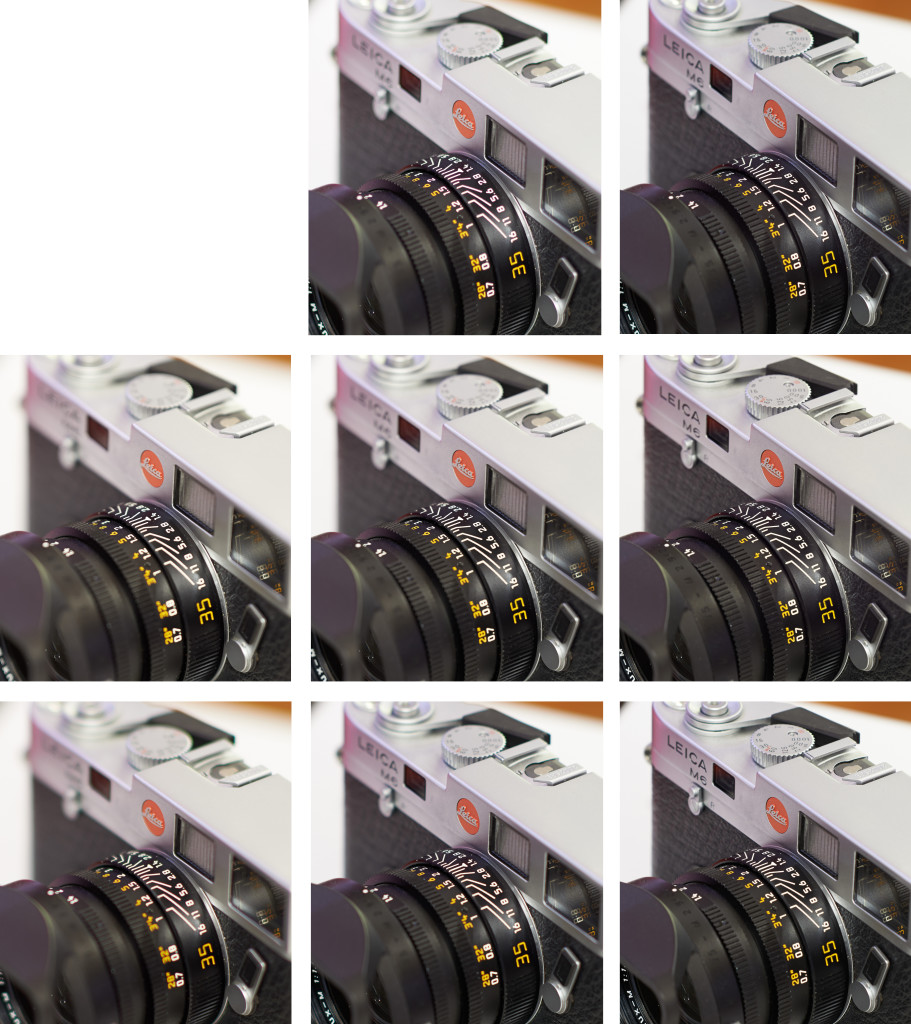
Zeiss Otus 85 f/1.4 Apo Planar shootout. 100% crops, click to enlarge. From left to right: f/1.4, f/2.8, f/5.6. Top: Nikon PC-E 85 mm. Middle: Otus 85. Bottom: Nikon 85 f/1.4 G.
Yesterday I picked up some accessories at Euro-Photo Puig in Geneva, where they had on stock a Zeiss Otus 85 mm f/1.4 Apo Planar T*. This is a mouthful of a name, so I call it Otus 85 from now on. I had the opportunity to take a couple of sample images, however, not out the store’s door as originally planned. It had started snowing, which rendered the scene useless as test for sharpness and micro-contrast. So what else is there to photograph inside a photo store than a nice vintage camera?
As usual, I exerted strict shot discipline; tripod mounting, focusing in live view (on the little triangle of the depth-of-field indicator on the lens), mirror lock up, three seconds shutter delay, RAW capture, and processing in Capture One Pro. The sample images show 100% crops from the left third of the frame, at apertures 1.4, 2.8 and 5.6 (form left to right). The white balance was fixed to the same value and no additional sharpening or removal of color fringes was made in the RAW processor.
The competitors of the Otus 85 were the Nikon 85 PC-E and 85 f/1.4 lenses, which are the references in this focal length.
Like all members of the Zeiss family, the Otus 85 is built to the highest standards, except for the plastic lens hood. However, the lack of autofocus remains a bit of an anachronism these days. For portraiture it is difficult to focus this lens manually without a split-image screen. Focus confirmation is just not precise enough, focus peaking is not available in the D810 and therefore live view is the only sensible option for the use of the Otus. The focus ring has a very small thread pitch and turns smoothly with just enough resistance to stay put. In contrast, the focus ring on the 85 PC-E requires adjustments on the milliradian level. The Otus 85 can be focused as close as 0.8 m, compared to 0.91 m for the 85 f/1.4 and 0.39 m for the PC-E. This allows cropped headshots, as it should be for what is usually known as a portrait lens.
The image samples speak for themselves. At 1.4 the Otus is much sharper than the 85 f/1.4 and exhibits less of the longitudinal chromatic aberrations (bokeh fringing) that manifest themselves as color fringes along boundaries separating dark and bright parts in the out-of-focus areas. At f/2.8 sharpness and fringing are improved for the 85 f/1.4 but still don’t match the performance of the Otus. Aperture 2.8 is wide-open for the PC-E and it shows, more in comparison to the Otus though. At aperture 5.6 all lenses show excellent results, where the PC-E beats the 85 f/1.4 for the slightest of margins and at a close call to the Otus.
So what prevents me then from taking a loan on the house and garden? In the digital area, camera bodies have a half-life of no more than 12 months*. Lenses are more of an investment, because you can’t defeat the laws of optics. As the rumor mill is saying, we will soon have 50 MP full-frame DSLRs (Canon 5Ds?), hopefully with suitable supporting technologies involved; ultra-precise focusing help, electronic first curtain. Alternatively, the larger 50 MP CMOS sensor from Sony, which is currently integrated in the Pentax 645z and the Mamiya/Phase One systems, may appear in a mirrorless camera (A9?). I could do without the clumsy mirror boxes of medium format indeed; a shorter flange focal distance would also allow such a camera to be used as a capture back on a technical field camera, my Linhof is waiting.
While the Otus clearly has the resolving power for a 50 MP full-frame sensor, its 43 mm image circle would not be enough to cover medium format. Better to hold out against the Otus lust – for now.
* And they are built this way: My Nikon F2 from the 1980s still looks better than my Nikon D800E, which shows fading paint, delaminating rubber, and contact problems on some of the buttons.